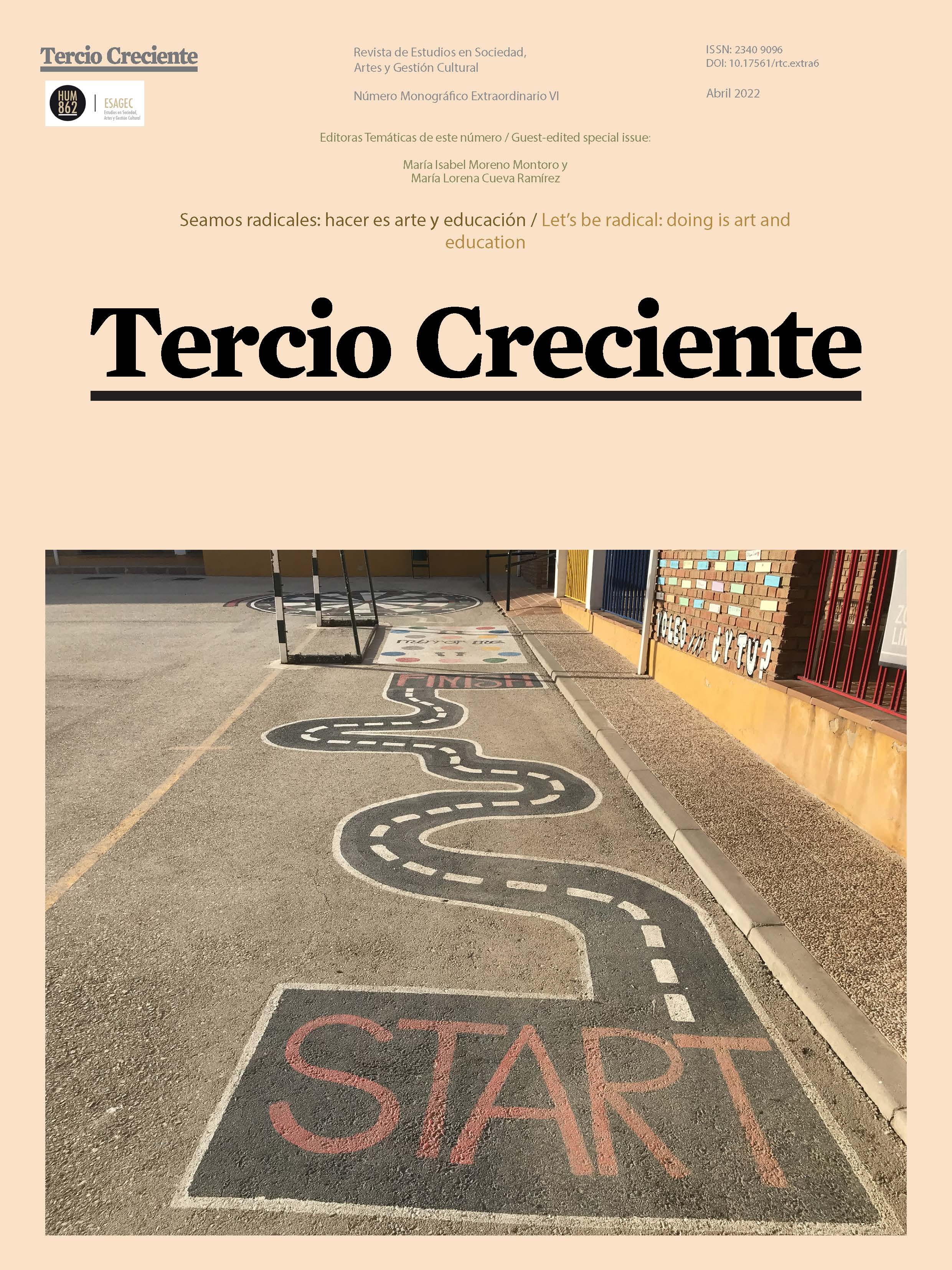La importancia de la autoexperiencia en el arte para los futuros maestros generalistas
DOI:
https://doi.org/10.17561/rtc.extra6.7008Palabras clave:
educación artística, educación experiencial, escuela primaria, profesores generalistas, investigación basada en el arteResumen
La actitud personal de los profesores hacia la materia que enseñan, su autoeficacia profesional y su experiencia son esenciales para su capacidad de transmitir el contenido de la materia al alumnado. Sin embargo, la relación de los futuros docentes con la materia se forma antes en su propia historia educativa que en la universidad. De ello deriva su interés por la materia y su posterior formación. Nuestra investigación ha demostrado que el alumnado de la especialidad de educación primaria y educación extraescolar tienen recuerdos negativos de la educación artística en la escuela primaria y evalúan la materia y sus beneficios como marginal.
En este artículo discutiremos cómo la transformación del enfoque didáctico al enfocarse más en el proceso creativo que en el producto puede afectar positivamente la relación ya establecida de los futuros docentes con la educación artística, y contribuir a la comprensión de los objetivos de la educación artística. Esta investigación estuvo dirigida a profesorado generalista (escuela primaria) y estudiantes de pregrado que trabajarán en clubes escolares o como educadores extraescolares. La investigación se segmentó en tres fases donde en la primera, utilizamos un enfoque cualitativo para determinar la actitud personal de los estudiantes hacia el tema de la educación artística. En la segunda fase, utilizamos el enfoque basado en el arte. En esta fase se aplicaron procedimientos didácticos inspirados en el arteterapia creativa y la educación experiencial reflexiva para cambiar esta actitud. Se eligió el enfoque basado en el arte principalmente porque permite monitorear los cambios que ocurren en el proceso y al mismo tiempo, gracias al proceso, es posible inducir estos cambios. Este tipo de investigación genera otras preguntas inesperadas que permiten una comprensión más profunda del problema. En la tercera fase el alumnado presentó sus obras y reflexionaron sobre los procesos creativos, así como sobre el curso en sí, sus beneficios, obstáculos y experiencias transferibles.
La conclusión de la investigación es que estos métodos pueden en muy poco tiempo cambiar la actitud hacia las propias habilidades creativas / autoconfianza creativa / para actualizar y ampliar la percepción del tema y sus objetivos. Al mismo tiempo, surge la necesidad de una formación profesional más profunda que facilite a los estudiantes la preparación didáctica de actividades artísticas significativas.
Descargas
Referencias
Bandura, A. (1977). Self-efficacy: Toward a unifying theory of behavioral change. Psychological Review, 84 (2), 191-215. https://doi.org/10.1037/0033-295X.84.2.191
Bandura, A. (1997). Self-efficacy: The exercise of control. New York: W.H. Freeman.
Bandura, A. (2006). Adolescent development from an agentic perspective. In F. Pajares & T. Urdan (Eds.), Self-efficacy beliefs of adolescents (pp. 1-44). Connecticut: Information Age
Bandura, A. (1994). Self-efficacy. In V. S. Ramachaudran (Ed.), Encyclopedia of human behavior (Vol. 4, pp. 71-81). New York: Academic Press.
Barone, T., Eisner, E. W. (2011). Arts Based Research. SAGE Publications.https://doi.org/10.4135/9781452230627
Caprara, G. V., Barbaranelli, C., Steca, P., & Malone, P. S. (2006). Teachers’ self-efficacy beliefs as determinants of job satisfaction and students’ academic achievement: A study at the school level. Journal of School Psychology, 44(6), 473-490. https://doi.org/10.1016/j.jsp.2006.09.001
Coemans, S., Hannes, K. (2017). Researchers under the spell of the arts: Two decades of using arts-based methods in community-based inquiry with vulnerable populations. Educational Research Review 22, 34-49. https://doi.org/10.1016/j.edurev.2017.08.003
Collins, A. (2016). Generalist pre-service teacher education, self-efficacy and arts education: An impossible expectation? International Journal of Education & the Arts, 17(26). Retrieved from http://www.ijea.org/v17n26/.
Denzin, N. K.; Lincoln, Y. (Eds.). (2000). The SAGE handbook of qualitative research. Thousand Oaks, CA: SAGE.
Eisner, E. W. (2002). The arts and the creation of mind. New Haven, CT: Yale University Press
Eisner, E. W., Day, M. D. (2004). Handbook of Research and Policy in Art Education. Mahwah: Routledge. https://doi.org/10.4324/9781410609939
Eisner, Elliot (2008). Art and knowledge. In J. Gary Knowles & Ardra L. Cole (Eds.), Handbook of the arts in qualitative research (pp.3-12) London: Sage. https://doi.org/10.4135/9781452226545.n1
Ellsworth, Elizabeth (2005). Place of learning: Media, architecture, pedagogy. New York: Routledge.
Garvis, S. (2008). Teacher self-efficacy for the arts education: Defining the construct. Australian Journal of Middle Schooling, 8(1), 25-31.
Garvis, S.; Pendergast, D. (2010). Supporting novice teachers of the arts. International Journal of Education & the Arts, 11(8). Retrieved from http://www.ijea.org/v11n8/.
Garvis, S.; Twigg, D.; Pendergast, D. (2011). Breaking the negative cycle: the formation of self-efficacy beliefs in the arts. A focus on professional experience in pre-service teacher education. Australasian Journal of Early Childhood, 36(2), 36-41. https://doi.org/10.1177/183693911103600206
Gavora, P. (2010). Úvod do pedagogického výzkumu. Brno: Paido.
Gerber, N., Templeton, E., Chilton, G., Liebman, M. C., Manders, E., & Shim, M. (2012). Art-based research as a pedagogical approach to studying intersubjectivity in the creative arts therapies. Journal of Applied Arts and Health, 3(1), 39-48. https://doi.org/10.1386/jaah.3.1.39_1
Härkönen, E. (2018). Teach Me Your Arctic: Place-Based Intercultural Approaches in Art Education. Borderless: Global Narratives in Art Education. Vol 35, 132-150.
Housego, B. E. (1990). A comparative study of student teachers’ feelings of preparedness to teach. Alberta Journal of Educational Research, 36(3), 223-239.
Karkou, V.; Sanderson, P. (2006). Arts Therapies. A Research based map of the field. Philadelphia: Elsevier.
Lawrence, R.L. (2008). Powerful feelings: Exploring the affective domain of informal and artsbased learning. In John M. Dirkx (Ed.), Adult learning and the emotional self. New directions for adult and continuing education, Vol. 120, 65-77. San Francisco, CA: Jossey-Bass. https://doi.org/10.1002/ace.317
Leavy, P. (2009). Method meets art: Arts-based research practice. New York, NY: Guilford Press.
Leavy, P. (2017). Research design: Quantitative, qualitative, mixed methods, arts-based, and community-based participatory research approaches. New York, NY: Guilford Press.
Lemon, N., & Garvis, S. (2013). What is the role of the arts in a primary school?: An investigation of perceptions of pre-service teachers in Australia. Australian Journal of Teacher Education, 38(9),1-9. https://doi.org/10.14221/ajte.2013v38n9.7
Lummis, G., Morris, J.; Paolino, A. (2014). An Investigation of Western Australian Pre-Service Primary Teachers’ Experiences and Self-Efficacy in The Arts. Australian Journal of Teacher Education. 39(5), 49-64 https://doi.org/10.14221/ajte.2014v39n5.4
Malchiodi, C. (1998). The art therapy sourcebook. NY: McGraw- Hill.
McNiff, S. (1998). Art-based Research. London: Jessica Kingsley Publishers.
Miovský, M. (2006). Kvalitativní přístup a metody v psychologickém výzkumu. Praha: Grada.
Oreck, B. (2006). Artistic choice: A study of teachers who use the arts in the classroom. International Journal of Education & the Arts, 7(8), 1-26.
Pajares, F. (2002). Overviev of social cognitive theory and of self- efficacy. Retreived from http://www.emory.edu/EDUCATION/mfp/eff.html
Pajares, F. (2006). Self-efficacy during childhood and adolescence. Implications for teachers and parents. In: Pajares, T., Urdan (Eds.), Self-efficacy beliefs of adolescents. 339-367. Greenwich, CT: Information Age Publishing. ISBN 978-1593113667
Pajares, T., Urdan, T.C. (Eds.) (2006), Self-efficacy beliefs of adolescents. Greenwich, CT: Information Age Publishing.
RVP. (2017). [online]. Rámcový vzdělávací program pro základní vzdělávání. Praha: Výzkumný ústav pedagogický. Retrieved from http://www.vuppraha.cz/wp-content/uploads/2009/12/RVPZV_2007-07.pdf>.
Řepa, K. 2019. Instantní výtvarka. In: Pospíšil, Řepa, Šobáňová (Eds.). Kvalita ve výtvarné výchově. Olomouc: Insea. 160-170.
Sawyer, K. (2012). Explaining creativity. NY: Oxford university press.
Seidel, S., Tishman S., Winner, E., Hetland, L. & Palmer, P. (2009). The Qualities of Quality. Understanding Excellence in Arts Education. Cambridge, Massachusetts: Harvard Graduate School of Education, Project Zero. Retrieved from https://www.wallacefoundation.org/knowledge-center/Documents/Understanding-Excellence-in-Arts-Education.pdf
Sternberg, R. J. (1999). Handbook of creativity. NY: Cambridge University Press.
Skaalvik, E., Skaalvik, S. (2010). Teacher self-efficacy and teacher burnout: A study of relations. Teaching and Teacher Education, 26(4), pp.1059-1069. Teaching and Teacher Education. 26. 1059-1069. https://doi.org/10.1016/j.tate.2009.11.001
Slavík, J. (2001). Umění zážitku, zážitek umění I.díl : teorie a praxe artefiletiky. Praha: UK- PdF
Sturken, M., Cartwright, L. (2010). Studia vizuální kultury. Praha: Portál
Šobáňová, P. (2012). “Co doopravdy jest” aneb vztah teorie a praxe ve výtvarné výchově. Pedagogická Orientace, 22(3), 404-427. https://doi.org/10.5817/PedOr2012-3-404
Štěpánková, K. (2019). Kvalita ve výtvarné výchově z pohledu studentů- výzkumná sonda. In: Pospíšil, A., Řepa, K. & Petra Šobáňová (eds.). Kvalita ve výtvarné výchově. Olomouc: Česká sekce INSEA, 69-85.
Tavşancil, E., & Yalçin, S. (2016). Attitudes of primary school prospective teachers towards art education. New Trends and Issues Proceedings on Humanities and Social Sciences, 2(1), 667-674. https://doi.org/10.18844/gjhss.v2i1.1009
Tschannen-Moran, M., Woolfolk Hoy, A., Hoy, W.K. (1998). Teachers efficacy: Its meaning and measure. Review of Educational Research, 68, 202-248. https://doi.org/10.3102/00346543068002202
van der Vaart, G., van Hoven, B., & Huigen, P. P. P. (2018). Creative and arts-based research methods in academic research. Lessons from a participatory research project in the Netherlands. Forum Qualitative Sozialforschung, 19(2). https://doi.org/10.17169/fqs-19.2.2961
Wang, Q., Coemans, S., Siegesmund, R., & Hannes, K. (2017). Arts-based Methods in Socially Engaged Research Practice: A Classification Framework. Art/Research International: A Transdisciplinary Journal, 2(2), 5-39. https://doi.org/10.18432/R26G8P
Welch, A. (1995). The self-efficacy of primary teachers in art education. Issues In Educational Research, 5(1), 71-84. http://www.iier.org.au/iier5/welch.html
Descargas
Publicado
Número
Sección
Licencia
Derechos de autor 2022 Kateřina Štěpánková

Esta obra está bajo una licencia internacional Creative Commons Atribución 4.0.
Aquellos autores/as que tengan publicaciones con esta revista, aceptan los términos siguientes:
- Los autores/as conservarán sus derechos de autor y garantizarán a la revista el derecho de primera publicación de su obra, el cuál estará simultáneamente sujeto a la Licencia de reconocimiento de Creative Commons que permite a terceros compartir la obra siempre que se indique su autor y su primera publicación esta revista.
- Los autores/as podrán adoptar otros acuerdos de licencia no exclusiva de distribución de la versión de la obra publicada (p. ej.: depositarla en un archivo telemático institucional o publicarla en un volumen monográfico) siempre que se indique la publicación inicial en esta revista.
- Se permite y recomienda a los autores/as difundir su obra a través de Internet (p. ej.: en archivos telemáticos institucionales o en su página web) antes y durante el proceso de envío, lo cual puede producir intercambios interesantes y aumentar las citas de la obra publicada. (Véase El efecto del acceso abierto).
En caso de ser aceptados, los trabajos se publicarán bajo licencia Creative Commons.






















